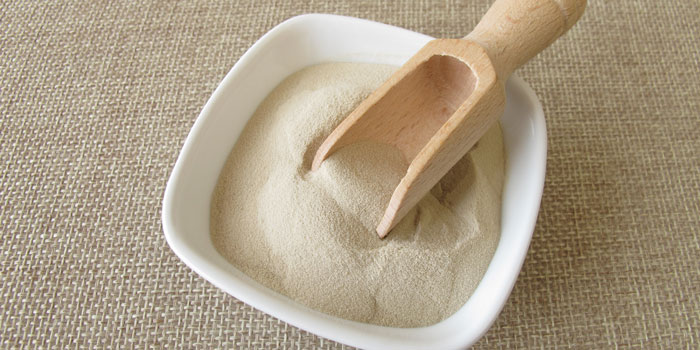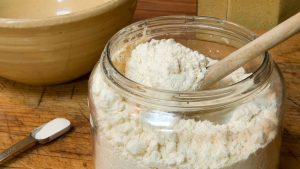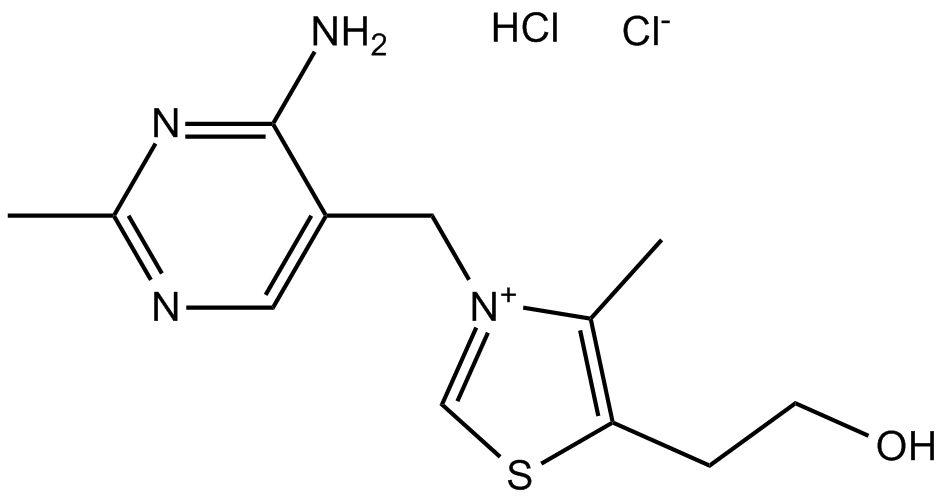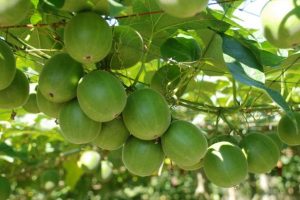What is Agar agar E406?
Agar agar meaning: same as Agar, Agar agar E406 is a natural hydrocolloid extracted from red algae such as Gracilaria and Gelidiume from sea, used as gelling agent in food preparation. As one of the three most extensively applied algal hydrocolloids in the world, Agar agar is mostly used in the food, pharmaceutical, household chemical and bioengineering industry.
Agar agar does not require addition of other gelling agent or ions for gelation, and its strong gelling capacity allows Agar agar gels to be formed from with dilute solutions. The gels formed are firm and strong.
In food industry, agar-agar works as a gelling agent, thickener and stabilizer. It physically reacts with substance to form complexes and therefore is commonly used in beverage, jelly and puddings, ice-cream, chewy candy, canned food, meat product, fruit jam and dairy product. In Japan, Agar agar (Kanten) is clarified as dietary fiber and has more than 400 years of eating history.
Description
Odourless or has a slight characteristic odour. Unground agar usually occurs in bundles consisting of thin, membranous, agglutinated strips, or in cut, flaked, granulated or powdered forms. It may be light yellowish orange, yellowish grey to pale yellow, or colourless. It is tough when damp, brittle when dry. Powdered agar is white to yellowish white or pale yellow.
Solubility
Agar agar E406 Insoluble in cold water; soluble in boiling water
Other names for Agar agar
Agar thickening agent, agar agar seaweed, agar agar thickener, agar food additive
E number: E406
Agar agar structure
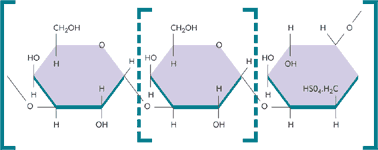
Chemical composition of Agar agar: two polysaccharides: agarose and agaropectin. Agar agar consists of a mixture of two polysaccharides: agarose and agaropectin, with agarose making up about 70% of the mixture.
Agarose, is a strongly gelling and the component in agar agar that forms a gel, non-ionic polysaccharide which is regarded as consisting of 1,3- linked β-D-galactopyranose and 1,4-linked 3,6-anhydro-α-L-galattopyranose units.
Agaropectin, Non-gel fractions, which are complex polysaccharides with sulfates, glucuronic acid and pyruvate aldehydes attached to it, that strongly influence solution properties, gelling kinetics and gel features.
Agar agar calories
26 calories per 100mg
Agar is obtained from?
Most agar agar is extracted from red algae species, especially from Gelidium and Gracilaria
Agar agar chemical formula
C14H24O9, for repeat unit
Gelatin substitute
Agar agar is a vegetarian substitute for Gelatin since it is a polysaccharide made from algae
Agar agar gell strength
Agar agar can be formed gel in very dilute solutions, containing a fraction of 0.5% to 1.0% of agar agar. The gels are rigid, brittle, have well defined shapes, as well as sharp melting and gelling points.Agar is a gel at room temperature, remaining firm at temperature as high as 65°C. Agar melting point at approximately 85°C, a different temperature from that at which it solidifies, 32-40°C. This property is known as hysteresis. The gel strength of the agar-agar is influenced by concentration, time, pH, and sugar content. The pH noticeably affects the strength of the agar gel; as the pH decreases, the gel strength weakens. Sugar content has also a considerable effect over agar gel. Increasing levels of sugar make gels with harder but less cohesive texture.
Agar agar E406 production
The basic principle in all processes for the production of Agar agar is simply an extraction of the agar from the seaweed algae Gelidium and Gracilaria after it has been cleaned and washed. This step is necessary to remove any foreign material such as sand, salts, sticks and any debris which may appear naturally with the seaweed.
Agar agar is extracted by heating in water for several hours. During this process Agar agar dissolves in the water. The mixture is then filtered to remove the residual seaweed. The hot filtrate is cooled and forms a gel which contains about one percent agar. The gel is broken into pieces and washed to remove all soluble salts, and, if necessary, it can be bleached to reduce the color. After this step, water is removed from the gel, either by a freeze-thaw process or nowadays more likely by squeezing it under pressure. Remaining water can then be removed by drying. The final step is to mill the agar to a suitable and uniform particle size.
There are some differences in the treatment of the seaweed prior to extraction, depending on the type of seaweed. With Gelidium the process is simply washing with plain water or sometimes with a little acid to facilitate extraction. Whereas Gracilaria must be treated with alkali before extraction to obtain the optimal gel strength. For the alkali treatment, the seaweed is heated in 2–5 percent sodium hydroxide at 85–90 ¢XC typically for one hour. After the removal of the alkali, the seaweed is washed with water, and sometimes with weak acid to neutralize any residual alkali.
For the hot-water extraction, Gelidium is more resistant. The extraction of this type of seaweed takes often place under pressure (105–110 ¢XC for 2–4 hours) as this is faster and gives higher yields. Gracilaria is usually just extracted with water at 95–100 ¢XC for 2–4 hours. The hot extract is given a coarse filtration to remove the seaweed residue, filter aid is added and the extract is passed through a filter press equipped with a fine filter cloth to ensure removal of any insoluble products.
Agar agar E406 Properties
- Agar agar is a versatile hydrocolloid completely soluble in boiling water.
- Agar provides odourless, colourless superior quality gels even at very low concentrations below 1%.
- Agar agar has good synergies with sugars and with different hydrocolloids.
- Agar agar is the strongest natural jelling agent and provides a thermo reversible gel.
- Agar agar solutions gel at temperatures from 35 °C to 43 °C and melt at temperatures from 85 °C to 95 °C.
- Agar agar is the only hydrocolloid that gives gels that can stand sterilization temperatures and has an excellent resistance to enzymatic hydrolysis.
- Agar agar does not require addition of other gels or ions for gelatinization.
- Agar agar reacts only with water which allows its incorporation in most of the food formulations.
- Agar agar is perfectly compatible with proteins, for example in dairy application.
Function of Agar agar E406
The function of Agar Agar is that it can be used as a thickener, coagulant, Suspending agents, emulsifiers, preservatives and stabilizers due to its properties.
At what temperature does Agar agar solidify?
The most useful characteristic of agar agar is that the big temperature gap between its freezing point and melting point. Agar is a gel at room temperature, remaining firm at temperature as high as 65°C. Agar melting point at approximately 85°C, a different temperature from that at which it solidifies, 32-40°C. This property is known as hysteresis.
It starts to melt when it is heated to 85°C or more in water, and it begins to solidify when the temperature drops to 40°C, so it is the best coagulant for preparing solid medium. The solid medium formulated with agar agar can be used for high temperature culture without melting.
Agar agar E406 Benefits
Agar agar made from Gracilaria and Gelidiume is an important vegetable gum. It is colorless and has no fixed shape, but it is solid and soluble in hot water. Agar agar can be used to make cold foods and microbial culture media. Agar is often referred to as agar or medicated flour, also known as stony gelatin. Agar agar can also be added to the recipe. Benefits of Agar agar like help bronchitis, pneumonia, phlegm, enteritis, lipid-lowering effects.
Agar agar can absorb water in the intestine, expand the contents of the intestines, increase the amount of stool, stimulate the intestinal wall, and help improve constipation. Therefore, people who are often constipated can properly eat some agar nuts. Agar agar is rich in minerals and a variety of vitamins, among which alginate substances have antihypertensive effect, and starch sulfate has lipid-lowering function, which has certain preventive and therapeutic effects on hypertension and hyperlipidemia. It can clear the lungs and phlegm, heat dampness, Yin and reduce fire, cooling blood to stop bleeding.
Agar agar E406 use in food
Agar agar is a polysaccharide extracted from seaweed and is one of the most widely used algae gels in the world. Agar Agar has a wide range of applications in the food, pharmaceutical, daily-use chemical industry, biological engineering, and many other use application. Agar Agar can be used for a thickener, coagulant, suspending agents, emulsifiers, preservatives and stabilizers due to its properties of coagulation, stability, and can form complexes with some substances. Agar agar is widely used in the manufacturing of beverages, jelly, jam, pastry, chocolate, bakery, sauce, dairy, ice cream, cakes, soft candy, canned foods, meat products, rice porridge, white fungus bird’s nest, quail foods, cold foods and so on. In the chemical industry, medical research, Agar Agar can be used as a medium, cream base and other uses.
It’s well known properties for a gelling agent, stabilizer and thickener. Agar agar can serve also as a natural source of vegetable origin dietary fiber and as an intestinal regulator. Once ingested, the powder hydrates and absorbs a large amount of water. This results in the consumer feeling fuller.
Agar agar use in food and how much agar agar to use
In Fruit juice
Agar agar is used for a suspension agent, the use of a concentration of 0.01-0.05%, can make the orange particles evenly suspended.
In beverage products, Agar agar is used, its role is to levitation force, so that the solids in the beverage suspension evenly, do not sink. It can ensure the long suspension time and shelf life, good transparency, good fluidity, smooth taste and no smell.
In soft candy/chocolate/cheesecake
Agar can also be used as a coagulator; thickening agent, emulsifier and stabilizer in the manufacture of confectionaries like gums, chocolate, cheesecake etc. The amount of Agar agar used is about 2.5%, and glucose, white sugar, etc. made of soft candy, its transparency and taste far better than other soft candy. We can give you the suggestion how to make agar agar pudding soft candy/chocolate/cheesecake.
Agar is used in solid foods. Its role is to coagulate to form a colloid, and as a main raw material to complex other accessories, such as sugar liquid, sugar, spices and so on.
In canned meat, meat products
0.2-0.5% Agar agar can form a gel to effectively bind the minced meat.
In cold food
First wash the agar, use boiling water to make it swell, picked up and add ingredients to eat.
In dairy products
Agar Agar is used in dairy based products like yoghurts, ice-creams, mousses, chocolate milks, custard tarts, custards etc. incorporation takes place at pasteurization stage. It is considered as a cost effective stabilizer for dairy products where water retention is of importance. It can also be mixed with other colloids to improve their final texture.
In pudding
A transparent strong elastic gel can be prepared with 0.1-0.3% agar and refined galactomannan. We can give you the suggestion how to make agar agar pudding.
In jelly
Agar agar in jelly used as a suspending agent, the reference amount of 0.15-0.3%, can make the particles evenly suspended, no precipitation, no delamination. We can give you the suggestion how to make agar agar jelly.
In jam and bekery
Agar agar is used as a thickening agent in low calorie marmalades, jams, processed meat products, bakery fillings, icings, prepared soups, ice-creams, etc. and as a gelation agent in doughnuts, low calorie marmalades, jams, jelly candy, fruit yogurts, acidified creams, cheese, puddings, custards, flans, fruit desserts, whipped fruit pulp, etc. Agar can also be used in spreadable products like honey, butter, peanut butter, jam products like honey butter, peanut butter, jam products (Substitution of pectin to decrease sugar level).
Types of Agar agar and their uses
As a Agar agar manufacturer and supplier, we supply Agar agar two types, powder and flake (strip) and these two types are the main types in the market.
How to make Agar agar dessert
Raw material: Agar agar, bayberry juice, rock sugar
Steps:
- Soak Agar agar in clean water. After 2 hours, boil the water in half a pot and add it to the agar until it is completely dissolved.
- Put the rock sugar in the bayberry sauce and stew it in a small simmer until the rock sugar dissolves in the bayberry juice.
- Mix the candied bayberry juice with agar and roll it over with slow heat, stirring continuously.
- Quickly pour the cooked juice into the container, cool it and put it into the freezer.
Agar agar safety
Agar agar, as a safe food additive is Generally Recognized as Safe (GRAS) by the US Food and Drug Administration (FDA).
Agar agar Maximum Usage Levels in food by FDA
Agar-agar (CAS Reg. No. PM 9002-18-0) is a dried, hydrophyllic, colloidal polysaccharide extracted from one of a number of related species of red algae (class Rhodophyceae ).
| Foods (as served) | Percent | Functions |
| Baked goods and baking mixes, 170.3(n)(1) of this chapter | 0.8 | Drying agent, 170.3(o)(7) of this chapter; flavoring agent, 170.3(o)(12) of this chapter; stabilizer, thickener, 170.3(o)(28) of this chapter. |
| Confections and frostings, 170.3(n)(9) of this chapter | 2.0 | Flavoring agent, 170.3(o)(12) of this chapter; stabilizer, thickener, 170.3(o)(28) of this chapter; surface finisher, 170.3(o)(30) of this chapter. |
| Soft candy, 170.3(n)(38) of this chapter | 1.2 | Stabilizer and thickener, 170.3(o)(28) of this chapter. |
| All other food categories | .25 | Flavoring agent, 170.3(o)(12) of this chapter; formulation aid, 170.3(o)(14) of this chapter; humectant, 170.3(o)(16) of this chapter; stabilizer, thickener, 170.3(o)(28) of this chapter. |
Agar agar side effects
Though Agar agar is considered safe, it may cause side effects such as mild diarrhea and, theoretically, when ingested with insufficient fluid, esophageal or bowel obstruction. Allergy to agar is possible.
- Side effects may include gastrointestinal irritation, pain, and diarrhea when agar is given in powdered form in large doses.
- Phytobezoars, which are rarely occurring concentrations of fruit and vegetable fibers in the gastrointestinal tract, have been reported following ingestion of high-fiber foods such as agar.
- Agar products may delay stomach emptying time and reduce the absorption of some drugs, herbs, and supplements. It is advised that these agents and agar be taken at different times to minimize potential interactions.
- Agar may reduce body weight and body mass index (BMI).
- Agar may lower blood sugar levels. Caution is advised in patients with diabetes or hypoglycemia, and in those taking drugs, herbs, or supplements that affect blood sugar. Blood glucose levels may need to be monitored by a qualified healthcare professional, including a pharmacist, and medication adjustments may be necessary.
- Agar may affect blood cholesterol levels. Use with caution in individuals with high levels of fats in the blood (hyperlipidemia) and those taking drugs, herbs, or supplements to treat this condition.
- Use with caution because agar and other fermentable fiber supplements enhanced tumor development in studies that chemically induced colon cancer in experimental animals.
- Use with caution in individuals taking laxatives, as use of agar with laxatives may have additive effects.
- Avoid in patients with bowel obstruction or swallowing difficulties, as agar use may worsen esophageal or bowel obstruction, particularly when taken with insufficient amounts of fluid.
- Avoid in pregnant or breastfeeding women due to a lack of available scientific evidence.
- Avoid in patients with an allergy/hypersensitivity to agar, its constituents, red seaweed, or related species.
Source: http://www.livingnaturally.com/ns/DisplayMonograph.asp?StoreID=3D9D155236034A5897378F7C5A033221&DocID=bottomline-agar
Agar agar FAQ
Where does agar come from?
Gelidium grows in the Atlantic Ocean along the Northern Coast of Spain, locally known as Cantabrian Sea and is considered to be amongst the most suitable raw material for the manufacture of high purity Agar-Agar.
Gracilaria can be found in different places such us Morocco, Chile, Indonesia, China and other countries.
Agar flakes vs powder
fake and powder are two forms of Agar, different use has different area uses, some like flake, some like powder.
Is Agar agar gluten free?
Yes, Agar agar is gluten free.
Difference between gelatin and agar agar
Source difference
Agar agar is a hydrocolloid extracted from red algae such as Gracilaria and Gelidiume from sea and it is Vegan.
Gelatin is a colorless and odorless substance that is extracted from animal skin and bones.
Gel temperature
Gelatin needs refrigeration to set and will melt at warm temperature.
Agar agar gel set at room temperature and the melting point at the temperature 85.
Difference between agar and Agar agar
Agar is also called Agar agar, they are same.
Agar agar Market
Agar agar E406 manufacturers
China is the big Agar agar E406 manufacturers and export country in the world.
There are several Agar agar E406 manufacturers in China and abroad, as you know, the price of China suppliers can be better than abroad manufacturers. We have worked with China top manufacturer for years, we would like to recommend our selected Agar agar E406 suppliers to you if you would like to save your purchasing cost with the same quality compared with abroad manufacturers. Agar agar E406 Samples are available if you need it for further test after accept the price.
Agar agar E406 price
As you know, there are many types of Agar agar E406 in the market, the price is based on different type. Now the price of Agar agar E406 is around USD/kg from China manufacturers and suppliers.
Where to buy Agar agar E406
All the products listed in our website are from the manufacturers we have worked together for many years. The professional working experience backup our confidence to their quality. We can supply Agar agar E406 for many Specifications and we can be your suppliers in China.
By using the appropriate Agar agar E406 types in your food, the formulator can create suitable products with good gelling agent, thickener and stabilizer. In addition to offering standard types, we works in conjunction with customers to develop new Agar agar E406 types (with different gel strength) for specific applications.
We’re committed to the quality and safety of our ingredients. We know that our customers expect us to use only the highest quality and healthiest ingredients available, and we do everything we can to satisfy those expectations. We feel confident in our choice to choose top Agar agar E406 manufacturer brand.
If you have any other questions, please email us through: info@foodsweeteners.com
Agar agar E406 grades in the market: powder and flake
Agar agar E406 kosher/halal: we can supply kosher and halal.
Agar Agar E406 market trend
The global Agar agar market size was estimated at USD 255 million in 2018 and is anticipated to grow. The exponential growth in the usage of this product is attributed to its various functional and health benefits. It contains 80% fiber and can be used as an appetite suppressant. It is also an important culinary ingredient as it acts as a substitute for gelatin and can be used as a thickener soups, in fruits preserves, ice cream and others desserts.
Rise in demand for vegetarian and vegan foods making the Agar agar popular
Consistent health risks associated with meat products is making people adopt a vegan lifestyle. A vegan diet reduces the risk of obesity, kidney stones, gall stones, lung cancer, adult-onset diabetes, colon cancer, gout osteoporosis, and breast cancer. Currently, many people are increasingly adopting veganism. Seaweed is the new vegan superfood.

